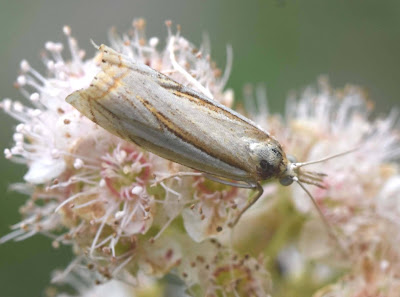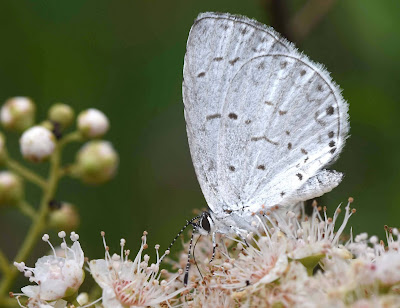Fragrance has long served the interests of roses by
attracting both natural pollinators and human propagators. The scent of our
native Halibut Point rose rivals the best of Syrian fragrances.
 |
Virginia rose, Rosa virginiana |
Compared to the privet, rose fragrance takes the high road emphasizing subtlety
over quantity.
 |
| Small Carpenter Bee, Ceratina sp |
Our rose draws admirers close with brightly colored petals,
where its perfume seals the enchantment. This pattern favors us visually-oriented
humans. It works well for various bees too, although bees can undoubtedly
detect the fragrance at a greater distance than our own smell-deficient
species.
 |
Bicolored Striped-sweat
Bee, Agapostemon virescens |
Bees of many descriptions fly to the flowers. They satisfy
their nutritional needs and carry pollen from the male stamens of one blossom
to fertilize the female pistils of another. Erotic elements weave through all
parties to the story ‒
flora, fauna, and civilization.
 |
Masked Bee, Hylaeus sp. |
Bumblebees can be frequently recognized among insects drawn
to the alluring rose. Yet I am puzzled at never having seen a honeybee in its
vicinity. That curiosity calls for further exploration.
 |
Two Miner Bees, Andrena
sp., and a Carpet Beetle, Cryptorhopalum
triste |
Within the vastly diverse insect world only one other order,
Coleoptera‒Beetles‒seems
to have in important role in the pollination of roses at Halibut Point.
Coleoptera derives from two Greek words, koleos meaning sheath and ptera meaning wings. Beetles are
distinguished from other insects by their front pair of wings (elytra) modified
into a protective, often colorful cover over their membranous pair of flight
wings. To fly, beetles have to hold their elytra outstretched. They
characteristically have chewing mandibles rather than piercing, sucking
mouthparts.
 |
Tumbling Flower
Beetle 1, Falsomordellistena pubescens |
Coleoptera, with about 400,000 species, is the
largest of all orders. It constitutes almost 40% of described insects and 25%
of all known animal life-forms.
 |
Tumbling Flower
Beetle 2, Mordella marginata |
Even the tiniest species are wonderfully diverse, complex,
and integrated to their circumstances.
 |
Long-horned Flower Beetle, Strangalia luteicornis |
The flattened dish of the Rosa virginiana inflorescence follows
the shape of most beetle-pollinated flowers. Its pollen is easily accessible
and the plant's ovaries are relatively well protected from the biting
mouthparts of beetles.
 |
Rose Curculio, Merhynchites bicolor |
Rose curculio weevils drill holes and lay eggs in developing
buds where their larvae feed on the reproductive parts of the flower. These
depredations may still serve the ultimate purpose of cross-fertilization as
pollen-covered beetles move from plant to plant. It would be interesting to chart
the balance of losses and gains from their activity.
 |
| Hairy Flower Scarab Beetle, Trichiotinus
affinis |
Some beetles disfigure flowers by chewing holes in the
petals. But petals are not an end in themselves. They exist to bring insects in
contact with pollen. In the case of roses, fragrance lies within the petals
themselves. They tempt, and are tempting to some tastes.
Roses concoct exquisite scents from an array of more than
300 chemical compounds, of which only 4 produce most of the fragrance. According
to Flower
Power Daily.com, perfume harvesters have to collect as many as 60 roses to
distill just one drop of essential oil and 250 pounds of petals are required to
make an ounce of it. Clearly, in its own sphere, each flower orchestrates its
grand purposes economically with only the tiniest potions released to the
breeze.







































